Humanity has created more artifacts than we could ever find uses for and many of these artifacts have become forgotten and left to collect dust and take up space. As we start to understand how to live in this post-industrial boom of a world we have to start to get creative with these old artifacts and reuse them instead of always pulling from our Earth’s limited resources. This practice has become known as upcycling. With this foundation, I created my upcycling project using 2 brackets from a failed project lying in my laboratory back closet.
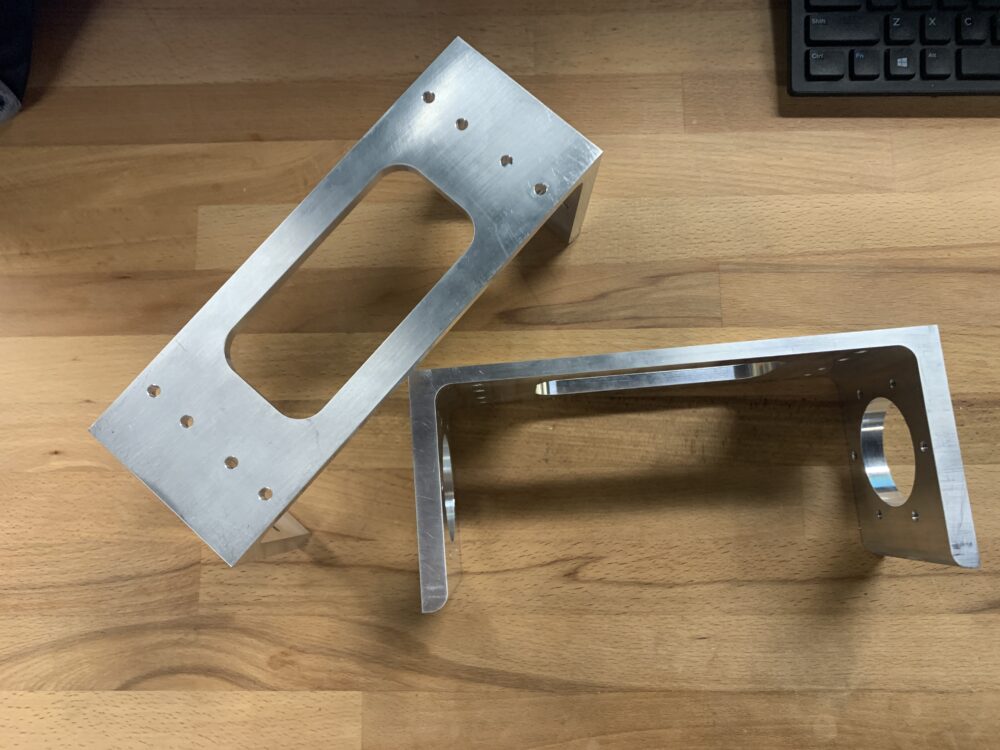 Image of Unused brackets for upcycling
Image of Unused brackets for upcycling
After knowing that I wanted to use these brackets in my project I started to think about what aesthetic I wanted to embody in my artifact and it felt only natural that like upcycling and industry waste I would use an industrial aesthetic.
The Industrial Aesthetic
A large craze that we have seen take over the world of interior design and so-called “hype” locations is industrial design. With its raw nature industrial design is characterized by exposed beams, harsh unpainted metals, exposed brick, strong angles, and an unfinished or unpolished feel.
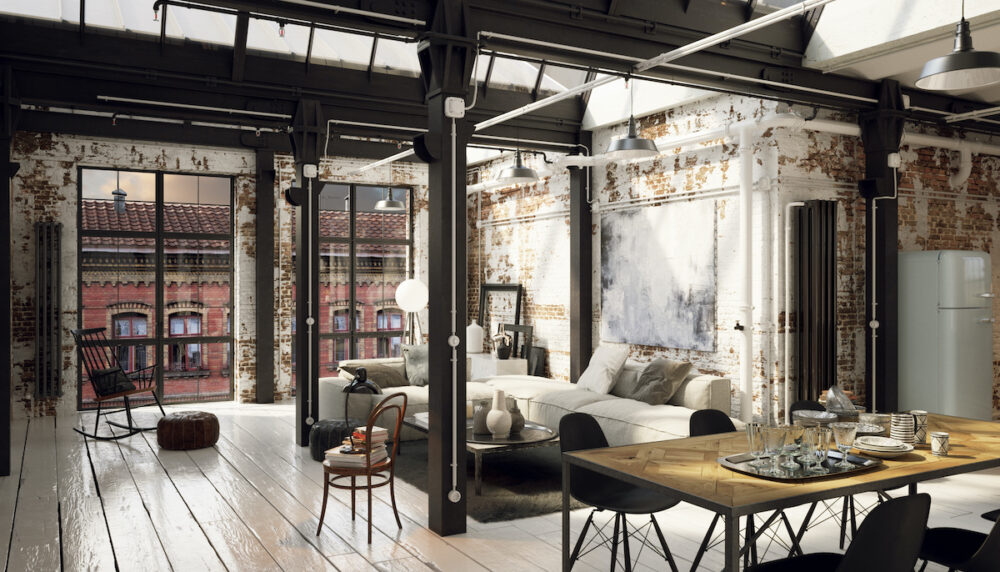
Image from: https://www.masterclass.com/articles/industrial-interior-design-explained
Though the aesthetic has grown in popularity tremendously in the last half century its true roots date back to the beginning of the Industrial Revolution in the mid-18th century. The design philosophy is not credited to one singular creator for it was more born out of necessity to be able to build quick and functional structures to keep up with the ever quickly growing cities the industrial revolution was flourishing in. However, many point to Christopher Dresser who lived from 1834 to 1904 and was a British designer and theorist who emphasized the marriage of form and function and advocated for mass production techniques, this ideology led to him being considered among the first independent industrial designers.
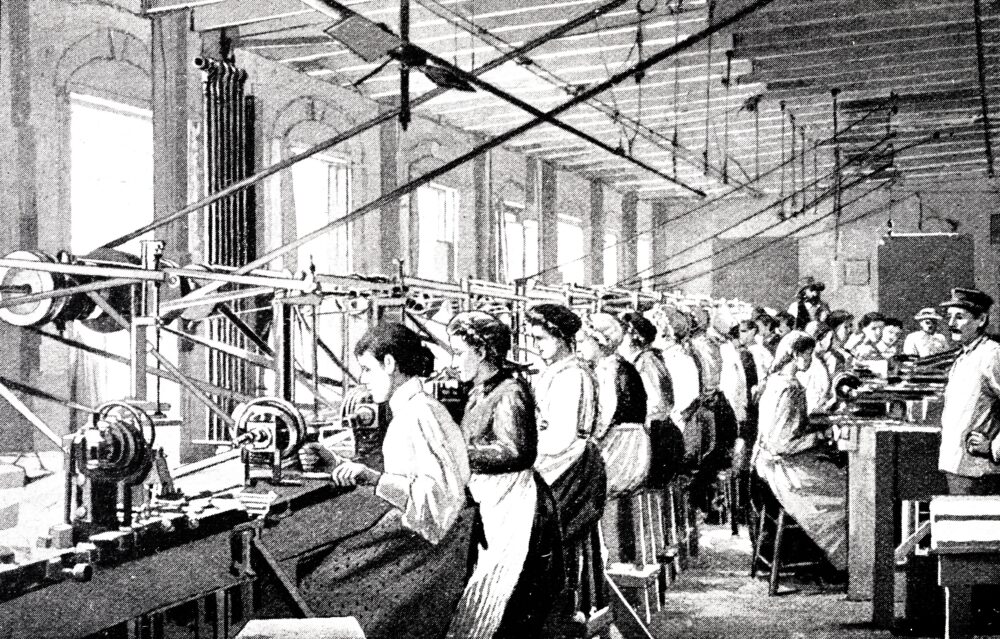
Image from: https://www.safetynational.com/conferencechronicles/the-4th-industrial-revolution/
This initial explosion of industrial design was mainly confined to factories and industrial areas where the function of the building was exclusively its effectiveness in developing consumer products. This trend of being the aesthetic of the industry continued until about the 1960s and 70s which is when old warehouses and factories got reimagined as living spaces because the so-called traditional living situations were becoming more and more difficult to find or afford.
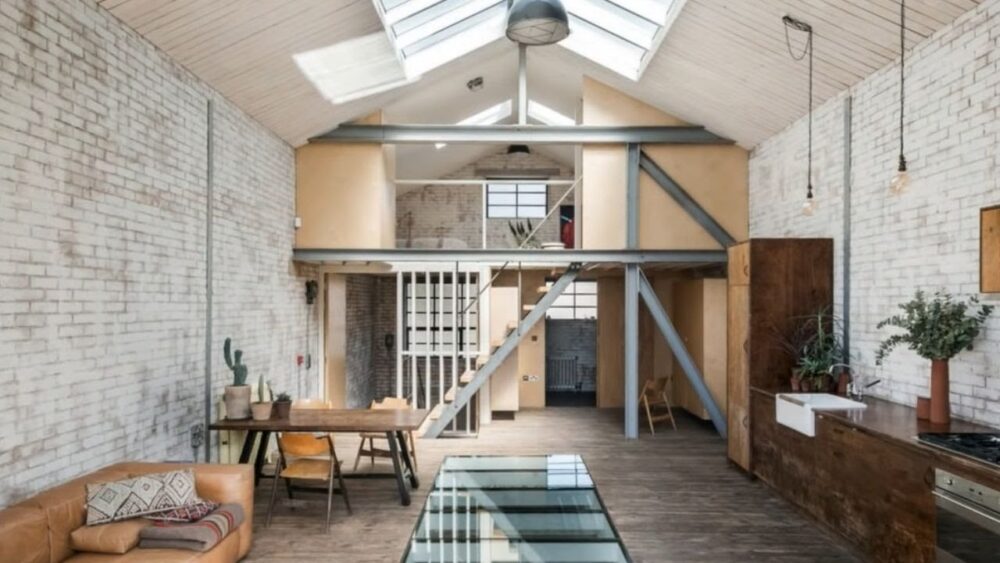
Image from: https://www.youtube.com/watch?v=3eoXfm-lL34&ab_channel=PineappleDECOR
This transition is the one that seems to be the large explosion that has led to the 21st century’s obsession with industrial design. With the increase in awareness of environmental issues and the shortage of new quality living situations, many have found a strong charm in these warehouse conversions. They have become so popular that new construction is even purposely designing its buildings to simulate this raw nature.
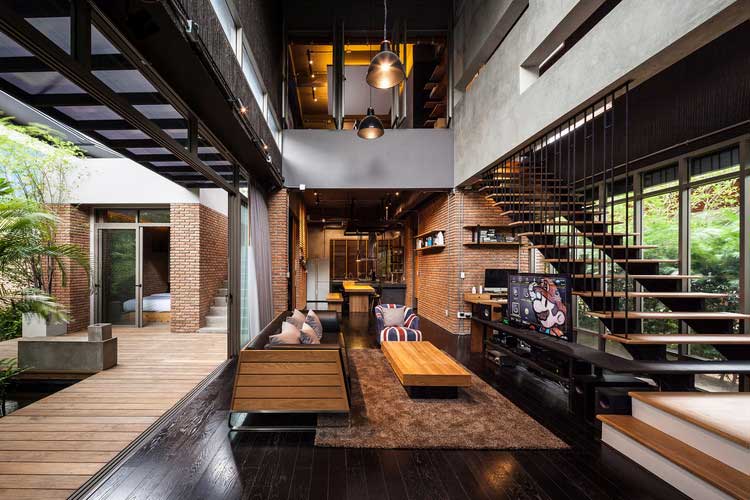
Image from: https://ciptabaliarchitect.com/industrial-architecture-design/
Though some people might see the choice of an industrial aesthetic as being lazy by the designer others find the raw nature extremely unique and like the feeling of having furniture and spaces that are special and very different from the “traditional” aesthetics of the western culture. In fact, it is in the furniture industry where the aesthetic of industrialism makes some of its most fascinating and eye-catching pieces.
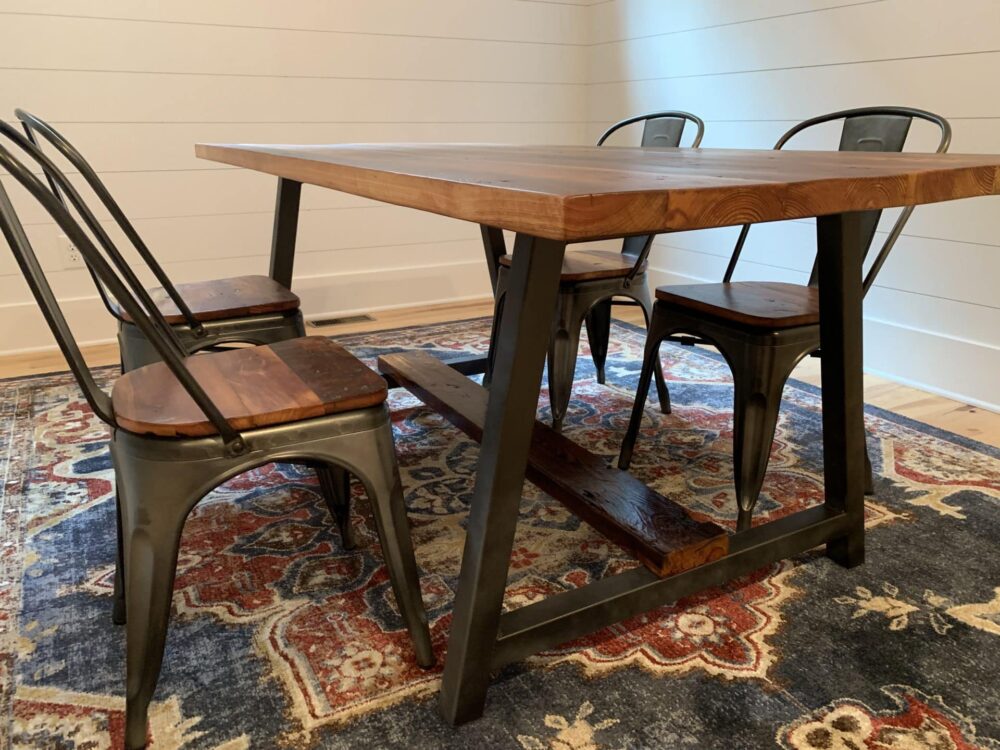
Image from: https://georgiaartisan.com/product/steel-a-frame-dining-table/
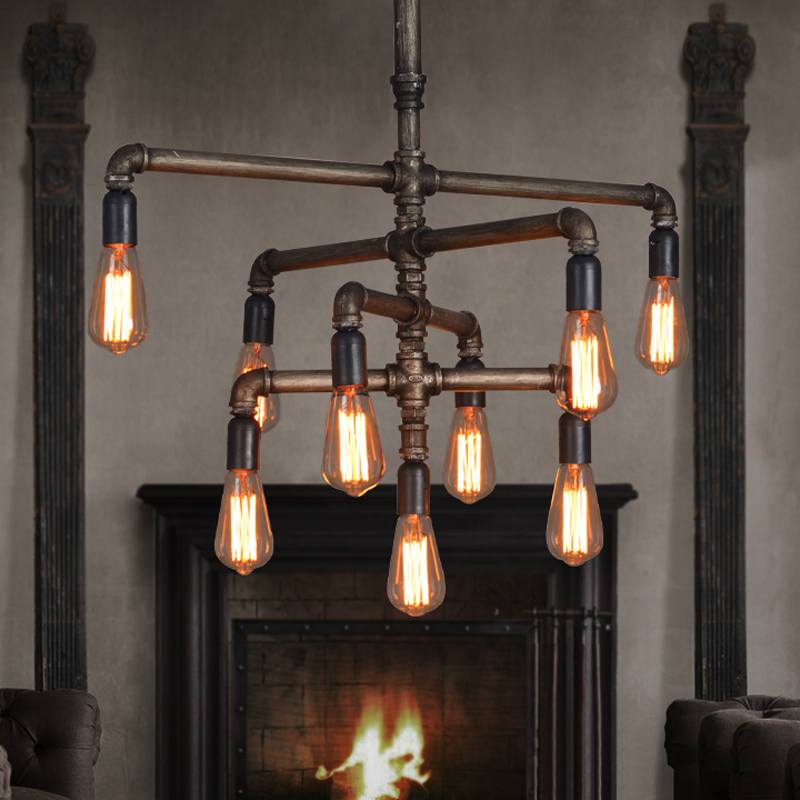
Image from: https://www.home-designing.com/vintage-retro-industrial-style-ceiling-wall-and-pendant-lighting
From its chairs and tables to just a simple lamp, industrial design makes an eye-popping discussion piece for its owner that due to the nature of the metals and angles they are created by also has unrivaled quality and durability.
The Industrial aesthetic has grown a lot from being born out of necessity in factories during the Industrial Revolution to being a unique and quality solution to a housing crisis to now being the bell of the ball for hip upper-middle-class houses. However, with my project, I look forward to using this aesthetic to pay homage to the original industrial designers of the Industrial Revolution with their unfinished metals and utility-first material selection techniques.
Design Process
I have always loved the look of a floating table and all the art that utilizes tensegrity to bring in an optical fascination to any artifact.
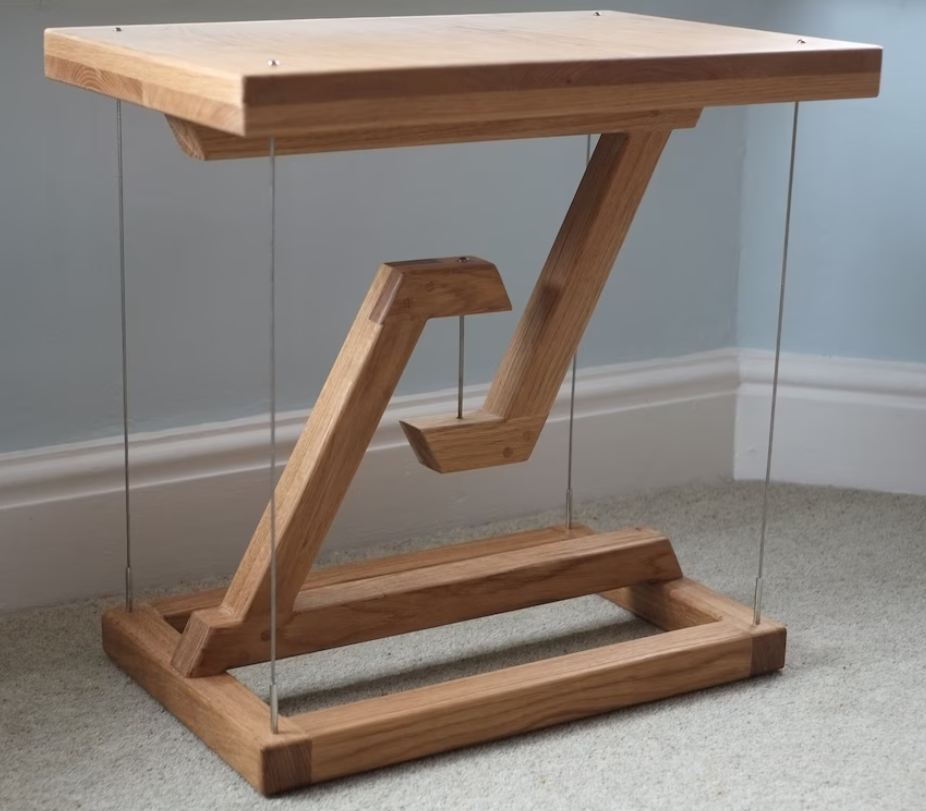
Example of a floating table by https://www.etsy.com/listing/844662800/solid-oak-floating-table-tensegrity
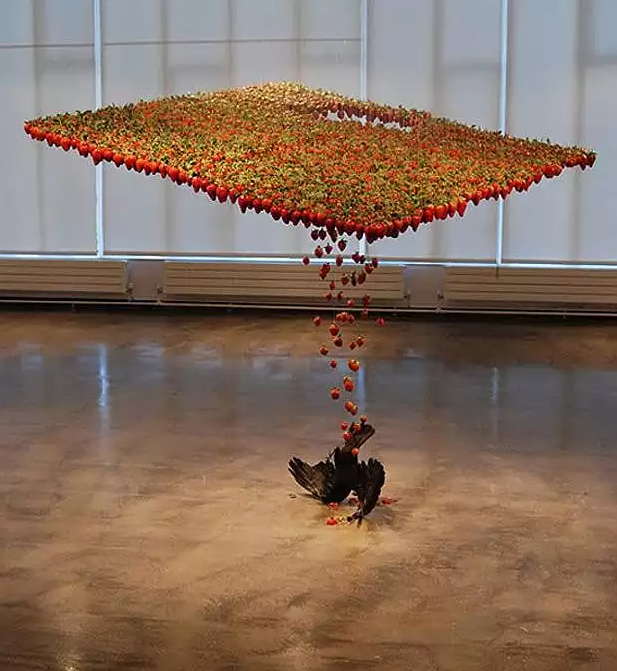
Float art installation by Clair Morgan at: https://www.designisthis.com/blog/en/post/floating-sculptures-claire-morgan
These types of floating tables and suspended art pieces have always caught my eye both visually and in an engineering sense. First, they made me awe at the way the floating members tell a story of isolation and yet fascination for they draw the eye right away and make them feel rebellious against the nature of all things fighting gravity so that they can have your attention. At the same time, my engineering brain loves to immediately start to form a free-body diagram around the piece and find the creative and sneaky ways that artists have found to balance their creations.
With this inspiration, I created a 3D model of my design to start to visualize what I was going to make.

CAD image of the brackets when the hole patterns are concentric. Notice the interference
After realizing that the hole patterns were not going to line up directly with each other thanks to this visual prototype I had to rethink how the tension cording would interface between the two brackets and came to the following conclusion:

Concept design for fabrication
This design lets the cords be vertically aligned to stop any weird torques from applying and horizontally holding due to the symmetry in the design. The last piece of this puzzle I had to solve was deciding on a cording that holds to both the aesthetic of industrialism and the sculpture concept of the floating tension table. To do this I searched for multiple different options to give myself a wide variety to decide between. I first thought of a fishing line so that it would truly give a floating bracket look. Unfortunately, I believe this doesn’t truly define itself as industrial enough and instead is almost a more futuristic aesthetic. With this concept in mind, I moved on to thinking about using an exposed electrical cable that looks more industrial. I started to enjoy this idea but unfortunately, I quickly started to worry about the strength of these cords in holding the sculpture up for an extended amount of time. Learning from both of these trials I searched for a stronger cord that has an industrial look to it still and I found my solution in black braided steel wire.

Image of black braided steel wire from: https://lifting.com/wire-rope-gac-black-719-316.html
Manufacturing
The last step of my process was to age the brackets a bit to make them fit the beaten metal aesthetic found in industrial design and assemble the sculpture. I used a sandblaster to strip away the shiny finish and create a raw look to the material.
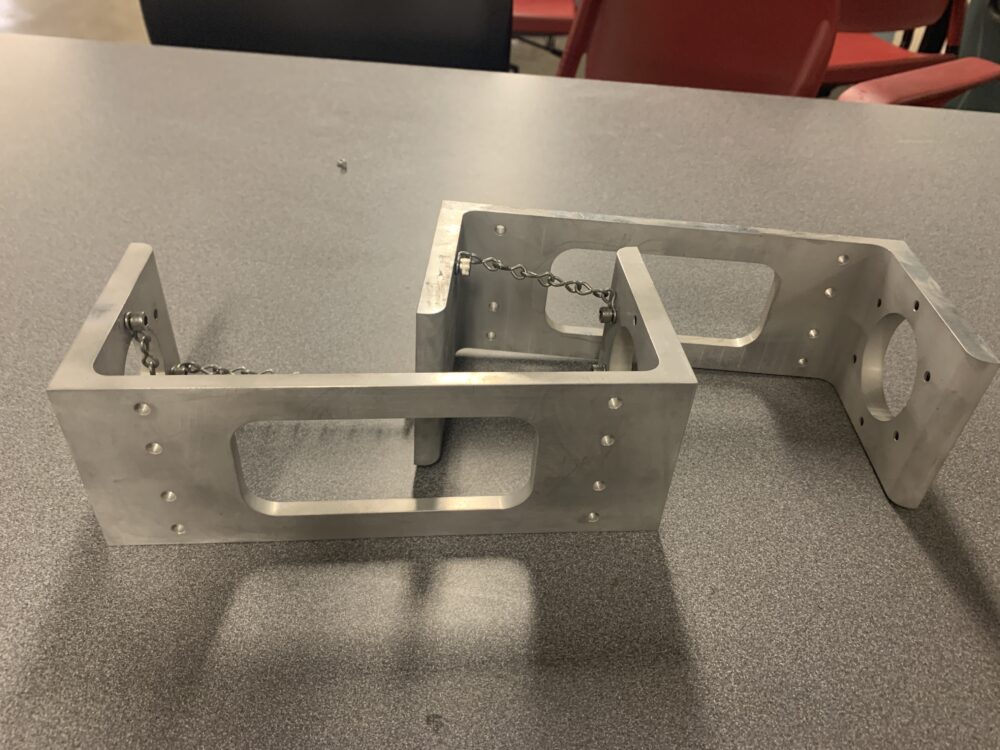
Post-sandblasting material finish
After finishing the brackets I started to work on assembling so I went to the community supplies fastener area and collected 16 10-24 bolts that can screw into the pretaps on the brackets.
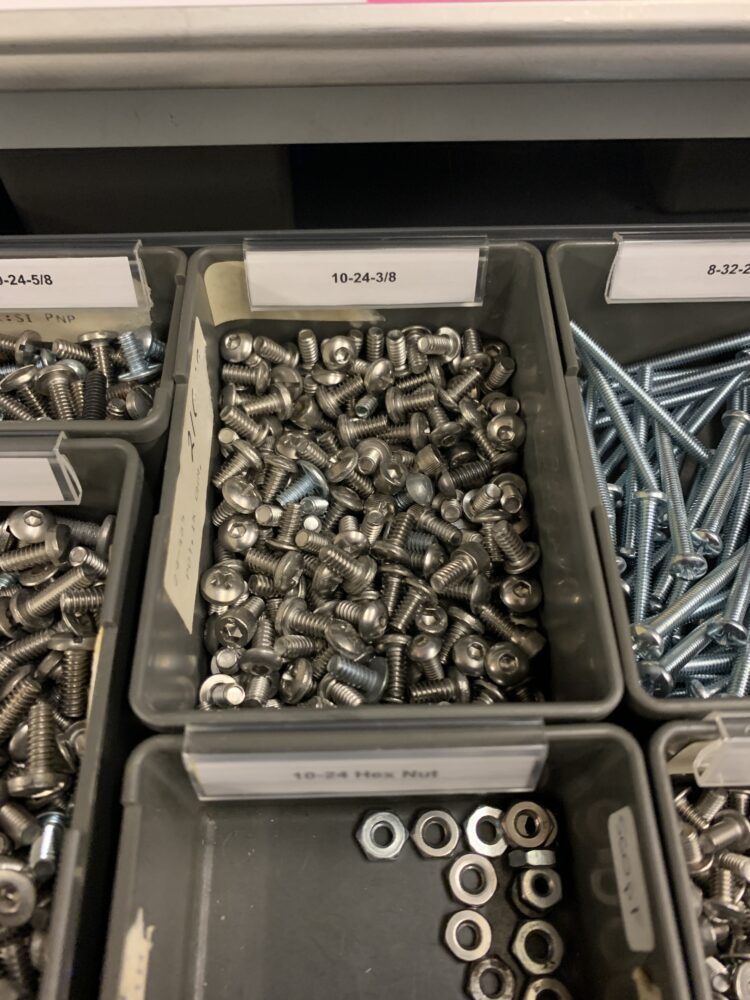
Fasteners supplies used for design.
After getting the fasteners I started to try and secure the braided steel wire to the brackets and was not at all happy with how the steel wire’s thin nature was coming across because it didn’t give the industrial aesthetic I was hoping for. So I started looking around for an alternative and I hit the jackpot when I found some chain-linked mesh.
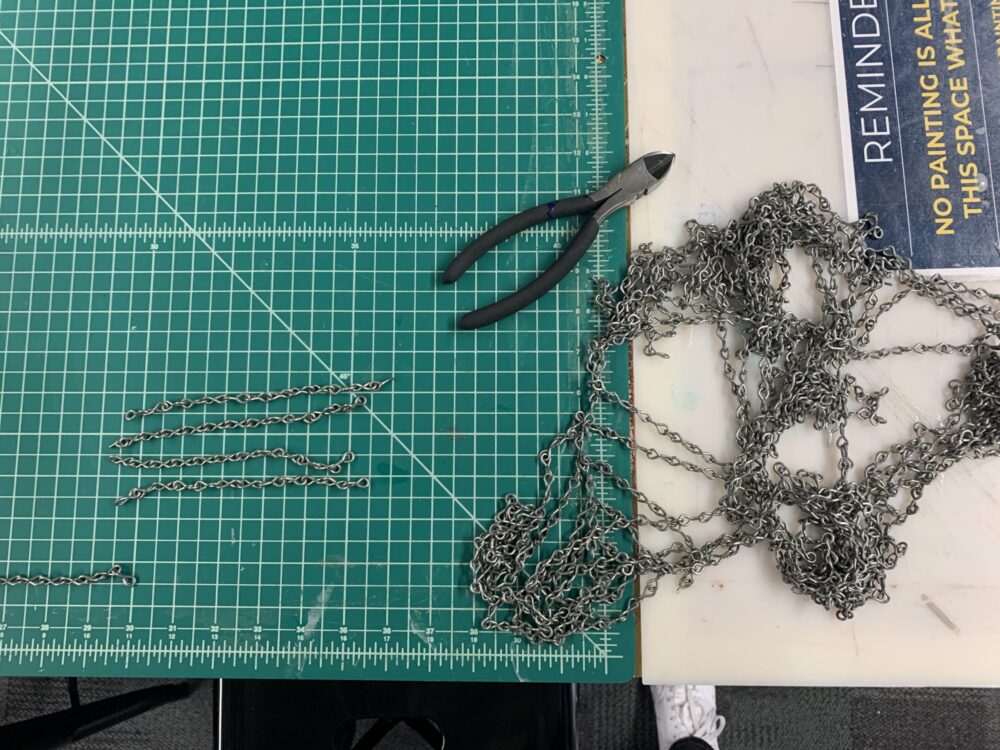
chain mesh with short pieces cut to get implemented into the design
These chain links were the perfect answer to embody my aesthetic and thanks to the links being able to be pried and molded I was able to wrap them around the fasteners to get an incredibly sturdy build. Now that I was happy with this I started to assemble one cord at a time.
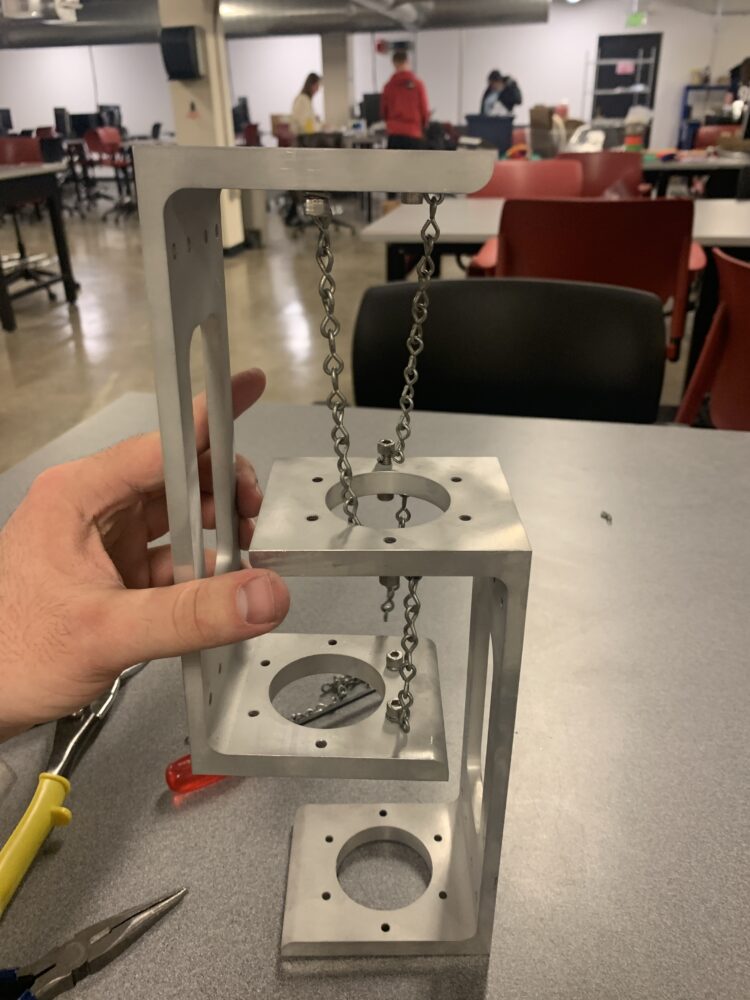
The initial length of the top and bottom with one chain on each side
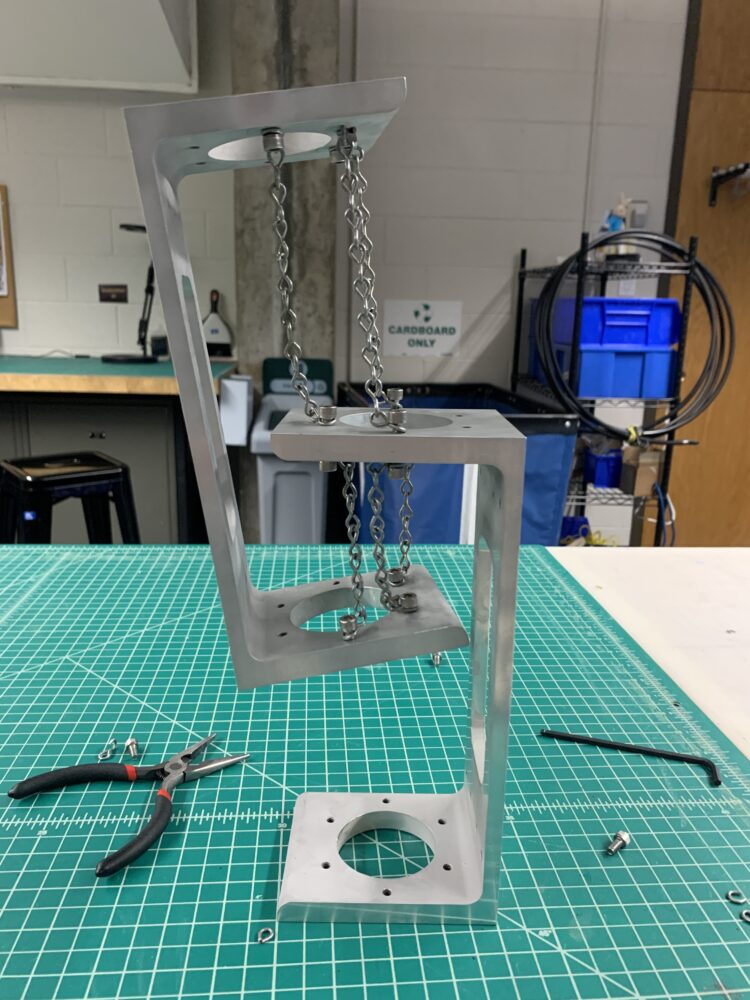
The first time they stood up alone missing one more chain
Final Product
After a few tweaks and changing the levels of the fasteners, I was able to level out the top bracket resulting in the following final product:
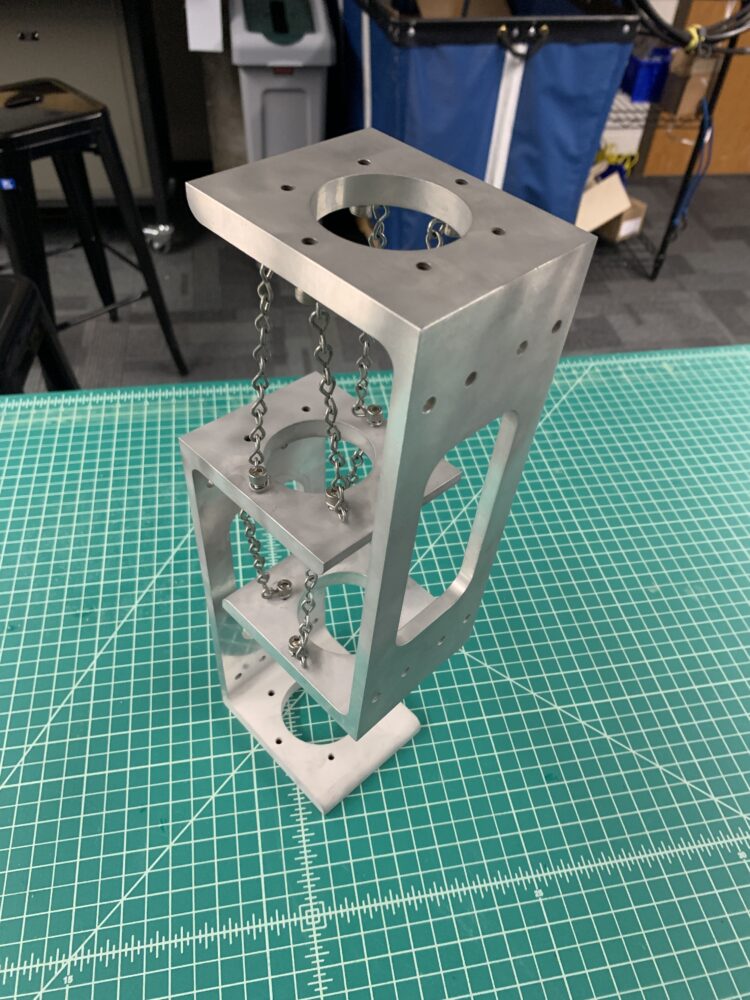
Isographic view of the final artifact
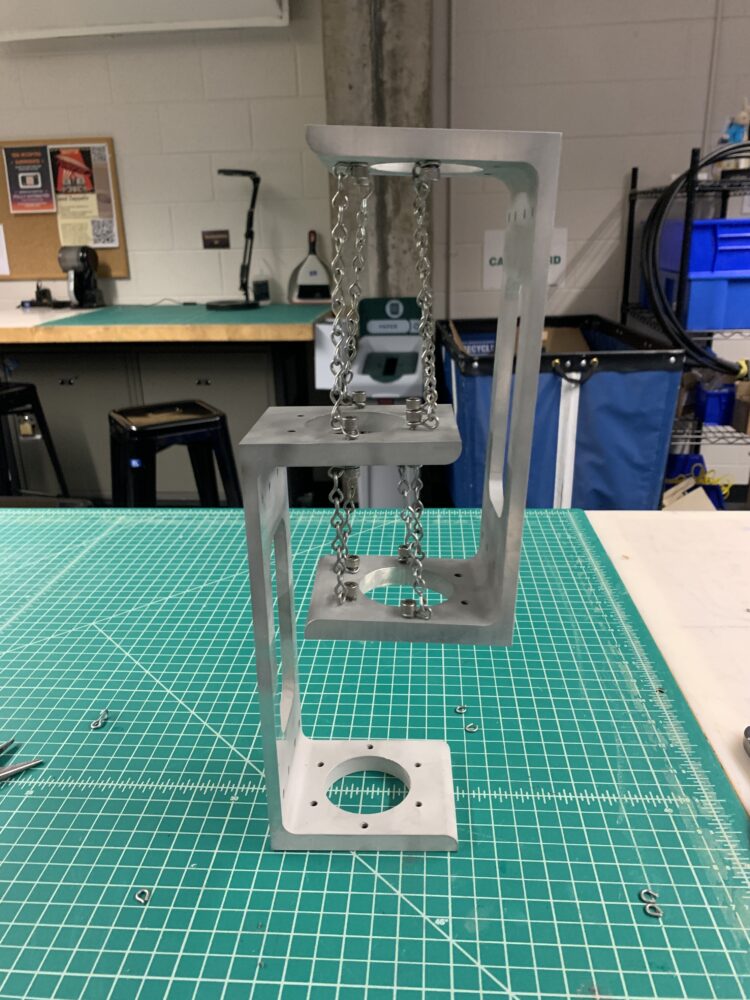
Front view of the final artifact
An interesting surprise from the design that I got that was super was that due to the tension of the chain and how the tensegrity design worked the artifact can be alternatively oriented into a horizontal format without losing the floating look.
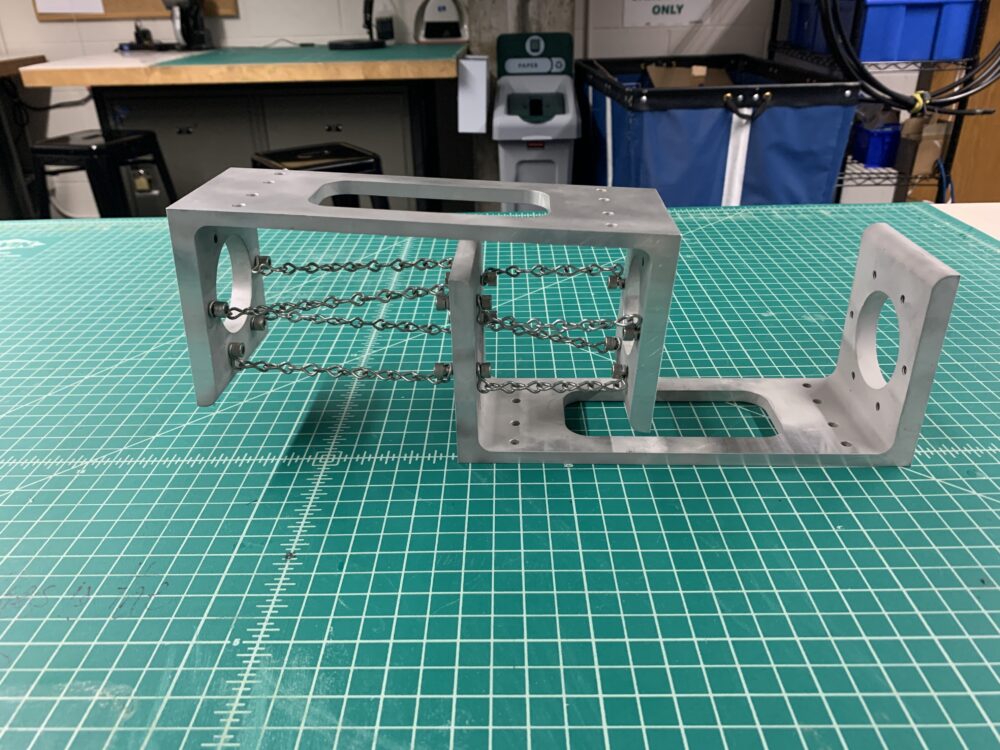
Horizontally oriented design surprise
I am extremely happy with how this project turned out and I believe that the horizontal capability demonstrates the quality of assembly in the design. I also am happy with how the design embodies the aesthetic of industrialism and I am so proud of being able to make it work well. Now I will forever have an amazing table piece that not only looks quality and is a fun fidget but it also reminds me that even if a mistake is made there can be beautiful unforeseen consequences.
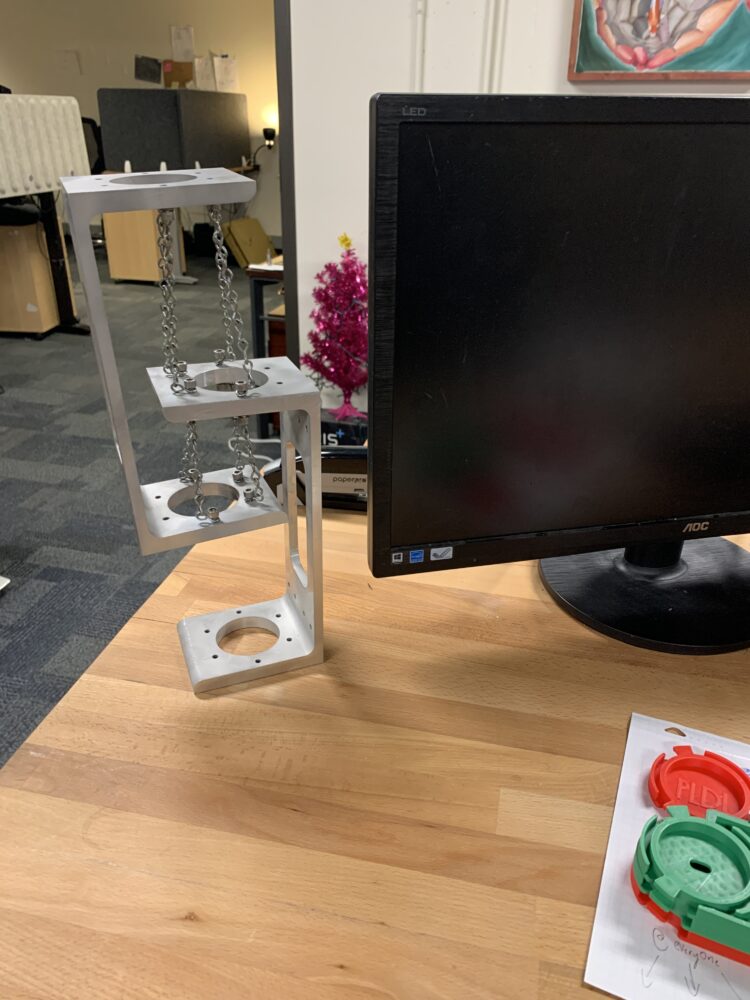
The sculpture is in its final resting place on my work desk for the whole lab to see.
Citations:
OpenAI. (2024). ChatGPT (3.5) [Large language model]. https://chat.openai.com
McLaughlin, K. (2023, April 17). Industrial Interior Design: Everything You Need to Know About This Raw and Commanding Style . AD. https://www.architecturaldigest.com/story/industrial-interior-design-101#:~:text=%E2%80%9CIndustrial%20interior%20design%20became%20popular,became%20more%20difficult%20to%20find.%E2%80%9D

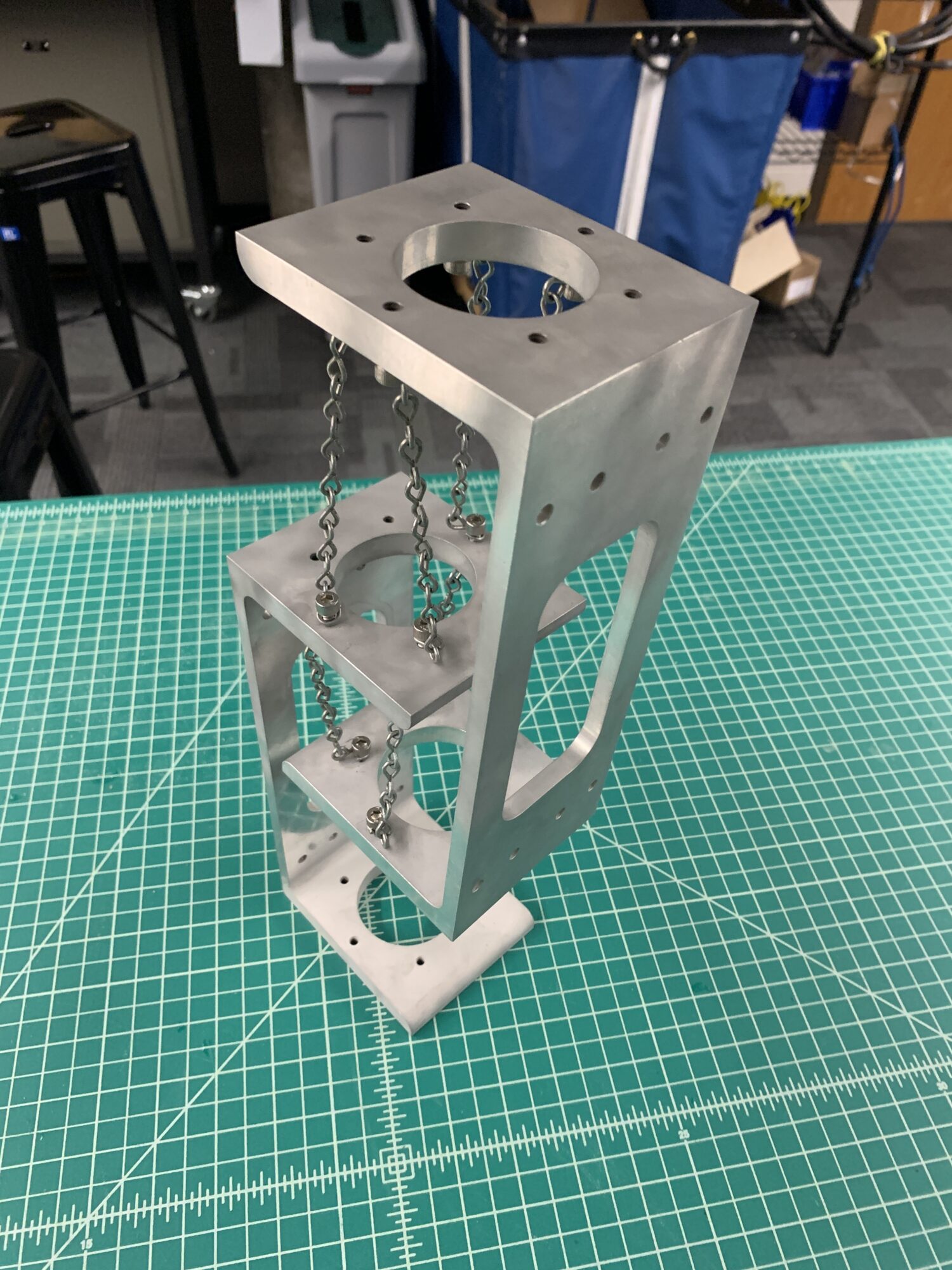
4 Comments. Leave new
I like your use of industrial design elements, especially the black braided steel wire and chain mesh, which effectively captures the rugged, raw aesthetic associated with the industrial era.
I’m curious on the durability of the final product. How does the tensegrity structure, which is visually fascinating, hold up under practical conditions such as weight-bearing and stability? It would be interesting to know more about the testing and refinement process to examine your project. But all in all this was an awesome project. Very impressed Colton.
The inspiration that you based your project off of is one that I can tell truly inspired you. Your final product is amazing, creative, and so unique! It is a project that you can enjoy and display. The different tiers of the table piece, with the circular holes, could allow you to add to the piece in ever-changing ways if you wanted to. My mind immediately envisions how you could add potted succulents to each tier, with their pots resting in those circular extrusions. It could be a cool way to explore multiple aesthetics. I loved learning about your creation process and the effort it took to make the brackets horizontal and achieve your vision. Great work!
I love that succulent idea I think I will definitely be taking that! Thanks for the feedback!
Your upcycling project utilizing unused brackets is truly remarkable and embodies the essence of creativity and innovation. Your dedication to repurposing forgotten artifacts into something visually striking and functional is commendable, and the thoughtfulness behind your design process is evident in every detail.
I appreciate your insightful exploration of the industrial aesthetic and its evolution over time. Your project not only pays homage to the roots of industrial design but also showcases its enduring appeal in contemporary settings. The use of raw materials, exposed elements, and functional form beautifully capture the essence of industrialism, creating a captivating visual and tactile experience.
Your meticulous design process, from conceptualization to fabrication, is truly inspiring. The incorporation of tensegrity principles and the choice of black braided steel wire add depth and character to the final artifact, elevating it from a mere functional piece to a work of art.
The aging process you applied to the brackets, along with the careful selection of chain-linked mesh, further enhances the industrial aesthetic and lends authenticity to the design. The final product, with its ability to be oriented horizontally, showcases your attention to detail and craftsmanship.
Overall, your project exemplifies the transformative power of upcycling and the beauty that can emerge from repurposing forgotten materials. I commend you for your creativity, ingenuity, and dedication to sustainability in design. Your artifact is not just a functional piece but a testament to the endless possibilities of reimagining the ordinary into the extraordinary.
Thank you for sharing your journey and your stunning creation with us. I look forward to seeing more of your innovative projects in the future!